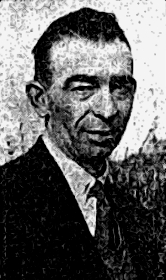Clann na Talmhan
This article has multiple issues. Please help improve it or discuss these issues on the talk page. (Learn how and when to remove these template messages)
|
Clann na Talmhan | |
|---|---|
| Founder and leader | Centre-left[1] |
Clann na Talmhan (pronounced [ˈklˠaːn̪ˠ n̪ˠə ˈt̪ˠal̪ˠwənˠ, - ˈt̪ˠalˠuːnˠ], "Family/Children of the land"; formally known as the National Agricultural Party) was an Irish agrarian political party active between 1939 and 1965.
Formation and growth

Clann na Talmhan was founded on 29 June 1939 in Athenry, County Galway, in the wake of the breakdown of unification talks between the Irish Farmers Federation (IFF) and representatives of farmers in Connacht on the rate-paying issue. While the IFF supported full derating, the western view was that the largest farmers should not be relieved of all their rate-paying obligations. Were this to happen, the western opinion was that indirect taxation would inevitably increase, and small farmers and workers would find themselves appreciably worse-off.
The party was led initially by Galway farmer
In contrast to the earlier Farmers' Party, Clann na Talmhan emphasised grass-roots campaigning and political agitation. It also developed an efficient electoral machine, largely owing to the advice and skills it gained from former members of Fianna Fáil. Although the party was hindered to a degree by wartime restrictions on public meetings and the press, it did have five years to prepare for its first election.
In 1943, Clann na Talmhan merged with the National Agricultural Party a rival political party setup in Leinster to represent the large farmers there, with the belief that the merger was needed in order to contest the upcoming 1943 general election. The unified party won ten seats in that election and nine at the 1944 general election. However, the merger of the two groups brought a great deal of instability as infighting between the small farmers from Connacht and the large farmers from Leinsters divided the party members. In light of this Donnellan resigned as leader following the election and was replaced by Joseph Blowick, a large farmer holder from County Mayo.[3]
In government and decline
The party was one of five parties in the
The party began to lose its position after its spells in government. A lack of improvement in the economy during this period led to disillusionment with Clann na Talmhan, and people again began to vote for Fianna Fáil and Fine Gael rather than small parties. During the 1950s many activists had departed, and the party became little more than a collection of personal electoral machines. By 1961, Donnellan and Blowick were the only party TDs remaining, and the party ceased to exist as an organisation independent of those men. When Donnellan died in 1964 his son John Donnellan was elected in his place, but for Fine Gael rather than his father's party. Blowick decided not to contest the 1965 general election, and Clann na Talmhan was formally wound up.
General election results
| Election | Seats won | ± | Position | First Pref votes | % | Government | Leader |
|---|---|---|---|---|---|---|---|
| 1943 | 10 / 138
|
130,452 | 9.8% | Opposition | Michael Donnellan | ||
| 1944 | 9 / 138
|
122,745 | 10.1% | Opposition | Joseph Blowick | ||
| 1948 | 7 / 147
|
73,813 | 5.6% | Coalition (FG-LP-CnP-CnT-NLP) | Joseph Blowick | ||
| 1951 | 6 / 147
|
38,872 | 2.9% | Opposition | Joseph Blowick | ||
| 1954 | 5 / 147
|
51,069 | 3.8% | Coalition (FG-LP-CnT) | Joseph Blowick | ||
| 1957 | 3 / 147
|
28,905 | 2.4% | Opposition | Joseph Blowick | ||
| 1961 | 2 / 144
|
17,693 | 1.5% | Opposition | Joseph Blowick |
See also
References
- ^ Coalition Governments in Western Europe by Wolfgang C. Müller, Kaare Strom pg129
- ^ Varley, Tony; Moser, Peter (25 January 2013). "Clann na Talmhan: Ireland's last farmers' party". HistoryIreland.com. History Ireland. Archived from the original on 25 July 2019. Retrieved 25 July 2019.
A flavour of the distaste for politicians and other establishment figures is well conveyed in Michael Donnellan's suggestion, at a Dunmore rally in 1942, that you could take all the TDs, all the senators, all the ministers and members of the judiciary and all the other nice fellows and dump them off Clare Island into the broad Atlantic. Still, Ireland would succeed. But without the workers and producers the country would starve in twenty-four hours.
- ^ Varley, Tony; Moser, Peter (25 January 2013). "Clann na Talmhan: Ireland's last farmers' party". HistoryIreland.com. History Ireland. Archived from the original on 25 July 2019. Retrieved 25 July 2019.
Sources
- Maurice Fitzgerald, 2000. "Ireland's European Integration, 1957 to 1966" in Protectionism to Liberalization: Ireland and the EEC, 1957 to 1966. Aldershot, UK: Ashgate. Open Access Copy
- Barberis, Peter, John McHugh and Mike Tyldesley, 2005. Encyclopedia of British and Irish Political Organisations. London: Continuum International Publishing Group. ISBN 978-0-8264-5814-8
- Manning, Maurice, 1972. Irish Political Parties: An Introduction. Dublin: Gill and Macmillan. ISBN 978-0-7171-0536-6
